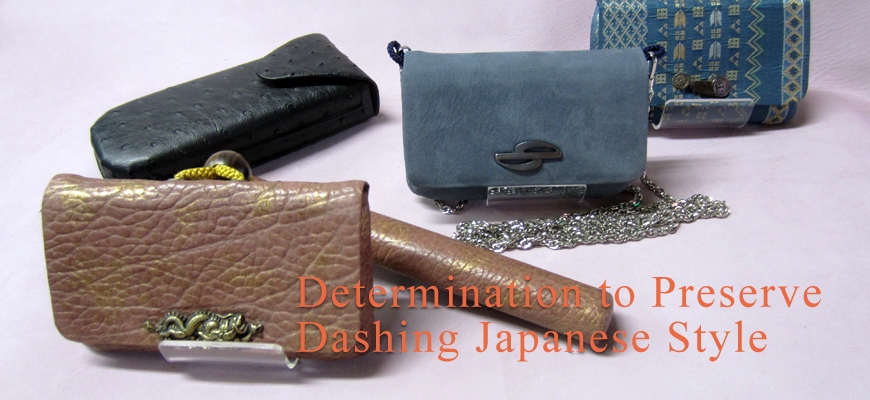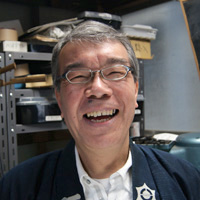
Naoyuki Fujii
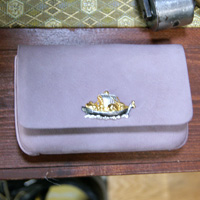
A custom-made tobacco sack
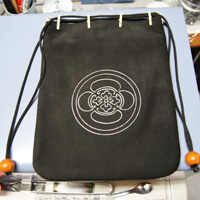
"Gassai Bukuro," or traveling sack. It is called so because everything (Gassai) is put in it.
What are Edo-style pouches?
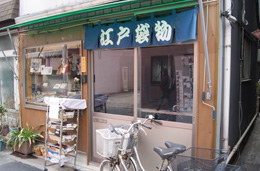
An episode of tobacco sacks from the Emperor
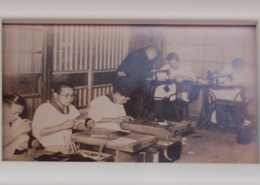
When the founder was alive, 150,000 Imperial tobacco sacks were delivered for soldiers, who would fought in the Manchurian Incident (1931), over several years. At that time, there were about 15 tobacco sack makers, so each maker took on a contract to make about 10,000 tobacco sacks. In the past, there was a bag store called "Maruemu Matsuzaki" in Yanagibashi, Taito City. The tobacco sacks were delivered from the Mitsukoshi department store via Maruemu Matsuzaki.
How did Fujii become an Edo-style pouch craftsman? What are Edo-style pouches?
Could you tell me about the reason you became an Edo-style pouch craftsman?
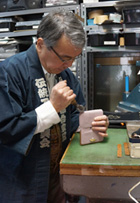
Could you tell me about what your job involves?
Processes of pouch making include cutting, edge skiving, sewing and finishing. I do not mass-produce pouches, and many of them are small, so, in many cases, I make pouches from the first to the last processes in a consistent way. I also make over other products into pouches. For example, I once made pouches out of a used short coat and hand towel. Some people ask me to make wallets out of obi that they inherited from the deceased because they will share the wallets among relatives.
Edo-style pouches
What kind of products do you make?
I study and make pouches, which were used in the Edo Period. Originally, my family made tobacco sacks. I have selected and made pouches that reflect the image of Edo, such as drawstring pouches, traveling sacks and carrier-bags.
What kind of materials do you use?
I mainly use leather, but sometimes use buckskin with patterns. A pouch made of buckskin with patterns has an atmosphere of Edo. I also use pieces of cloth. In addition to leather, I use everything that can be processed as materials for pouches.
In addition to traditional pouches, do you make redesigned pouches?
When what people put in pouches changes, I am motivated to make new pouches in response to the change. Many tablets are now sold, so I plan to make a pouch that can be used as a tablet case. The point is that when what people put in pouches changes, pouches also change.
Fabrication techniques
Could you tell me about detailed work processes?
For example, in the case of a typical tobacco sack, it is difficult to process edges of leather, which is folded after being cut, if the edges are thick, so the edges are skived by a machine. The skived edges are easy to be folded. After that process, the leather is backed. It is backed by a backing material such as cardboard. After this process, the leather is cut and fabricated. Then, I sew the fabricated leather by hand or a machine, and compete the processes by putting a stretcher into it.
Could you tell me about stretchers for tobacco sacks?
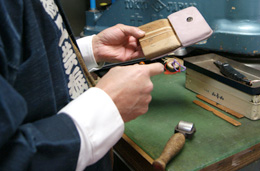
Insert a stretcher into a tobacco sack, and round off it using "Yose-nen," or tool to pinch, and a roller.
At which process is a special skill needed?
It takes a skill to round off this portion. Leather partially stretches, so it is easy to round off it. Although it is possible to round off cloth, it does not stretch as leather does. Some parts of a tobacco sack are just glued together, so I select the best glue to firmly glue them. Although there are several glues, such as "Saibinol," or vinyl acetate resin adhesive, glue and rubber cement, it is necessary to use different glues for different tasks. It is not possible to make a tobacco sack with one type of glue.
Tools
Could you tell me about tools you use?
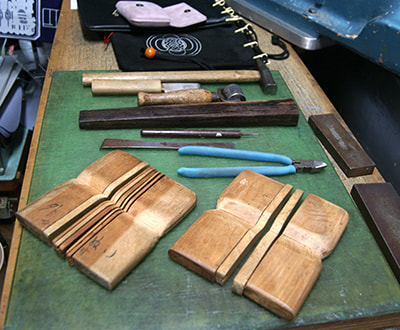
For example, pouch craftsmen use Yosenen to round off corners of a pouch. It is an important tool. There are also knives that are used to cut leather. I use those knives to cut leather according to paper patterns. I also use rollers to finish pouches. The rollers are useful to firmly paste leather. I had mainly used hammers before, but rollers are more useful when pasting leather together with even pressure.
Do the present tools differ from the past ones?
A hydraulic cutting machine is useful, but, in the past, such a machine did not exist. So, in the past, craftsmen beat quenched cutters with wooden hammers to cut out patterns. Also, sewing machines have been used since relatively early times. Craftsmen had already used sewing machines frequently when I was a child. I think a Sewing machine is a relatively old tool.
Pride as a craftsman
Could you tell me about your commitment to Edo-style pouches?
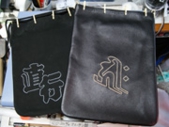
What is your pride as a craftsman?
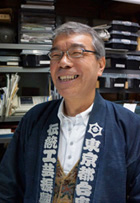
For example, when I tried to cut and fabricate silk that was lining cloth of a wallet, the silk became frayed. When I hesitated about what to do, I recalled that dry goods stores used "Hotsure-dome Kako," or process to fix frays. So I tentatively applied a spray glue to the silk. As a result, the frays were fixed. I thought I made it. When I feel I made it by contriving a variety of ways and means in this way, I find pouch making very interesting.

Naoyuki Fujii

A custom-made tobacco sack

"Gassai Bukuro," or traveling sack. It is called so because everything (Gassai) is put in it.
What are Edo-style pouches?

Edo-style pouches are equivalent to modern-day wallets, pouches and bags. "Fukuro-mono," or pouch, is a general term for saclike containers into which things are put. There are a variety of pouches, including a tissue pouch, traveling sack and satchel. In the Edo Period, tobacco sacks were valued as accessories among commoners, and it was said that all connoisseurs had stylish tobacco sacks.
An episode of tobacco sacks from the Emperor

A manufacturing scene at that time when the founder was alive (the image provided by Naoyuki Fujii)
When the founder was alive, 150,000 Imperial tobacco sacks were delivered for soldiers, who would fought in the Manchurian Incident (1931), over several years. At that time, there were about 15 tobacco sack makers, so each maker took on a contract to make about 10,000 tobacco sacks. In the past, there was a bag store called "Maruemu Matsuzaki" in Yanagibashi, Taito City. The tobacco sacks were delivered from the Mitsukoshi department store via Maruemu Matsuzaki.






